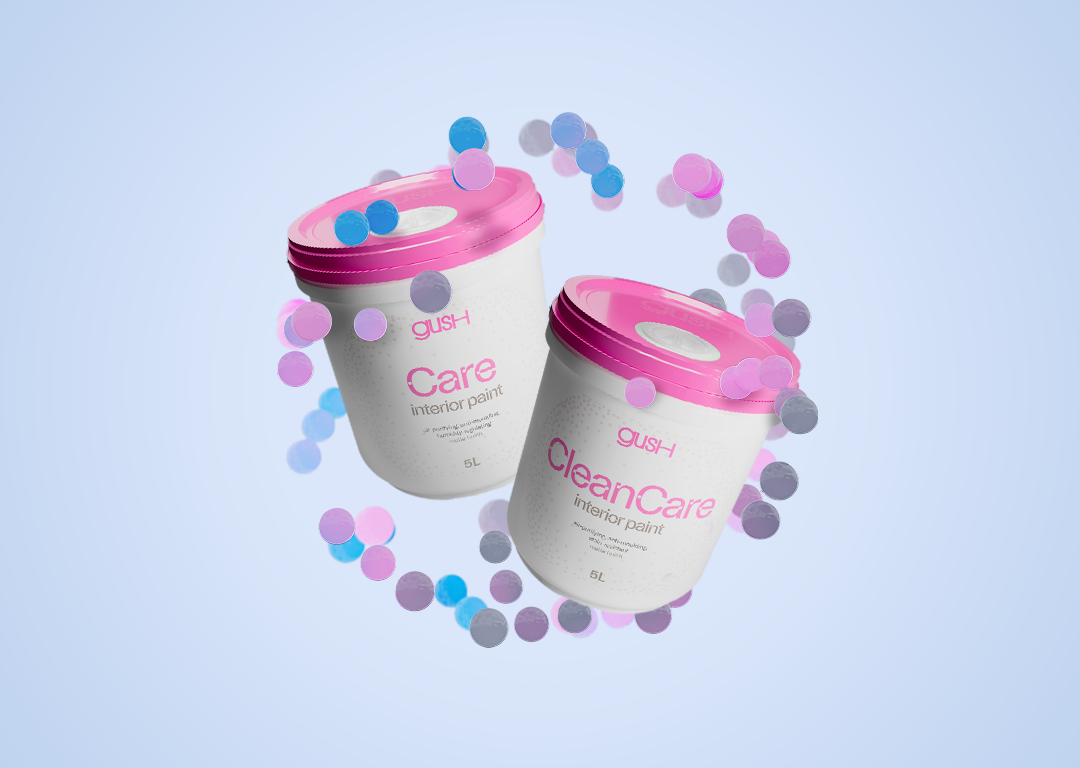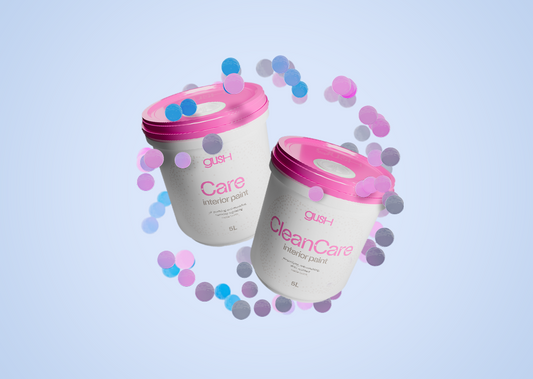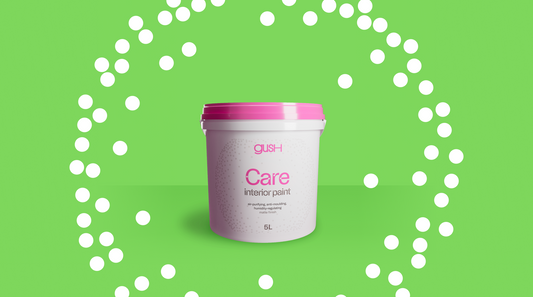Science
How effective are Gush paints in removing air pollutants?

Whatever you think air pollutants might be, Gush paints are tested to keep them out of your air.
It’s important for us to walk the talk. Put our money where our mouth is. All of us would love to have a solution that keeps our spaces flowing with pollutant-free air. Especially when many of us are concerned about indoor air pollution? But this doesn’t come without extensive testing, research and proof. If all of us are going to thrive in shared wellness, we need certified products to truly help us to get there. So let’s clear the air about what pollutants Gush paint purifies, how effective it is, and why it’s important to enjoy healthy air within your living spaces.
Breaking the myth: Air pollution happens indoors too.
For those of us who live in urban environments - that's about 4.4 billion of us, or 56% of humanity - we're spending up to 90% of our time indoors on average. None of us want our homes and indoor spaces to contain any air pollutants, let alone be filled with them.
Billowing clouds of dark smoke from factories or cities barely discernible through murky fogs might come to mind when we think of air pollution. While those are certainly unhealthy for us, similar pollutants can be present indoors too. But the comparatively smaller scale of our spaces means there isn't enough space to form the thick clouds we commonly see. If you do, it's definitely not a good sign – that's why indoor BBQ restaurants are required to have special ventilation systems to keep the air clean and safe.
Volatile organic compounds (VOCs) are a group of pollutants that have a significant impact on indoor air quality. Let’s find out why it’s important they be removed from your air as much as possible.

What indoor air pollutants are there?
There are 4 types of VOCs that our spaces are particularly susceptible to as they’re emitted by everyday household items.
1. Formaldehyde
2. Chlorinated aromatic compounds
3. Non-chlorinated aromatic compounds
4. Chlorinated aliphatic compounds
Formaldehyde is a colourless and foul-smelling gas. It is extremely volatile because it reacts with hydroxyl radicals in the air to form formic acid at room temperature. This irritates our eyes and skin. Belonging to the aldehyde group, it’s one of the most prevalent VOCs found in indoor environments. Common building materials and furnishings contain formaldehyde; including carpet, fibreboard and plywood. It’s also found in adhesives, cosmetics and cleaning products. So, it’s hard to completely avoid it.
Chlorinated aromatic compounds contain chlorine within their chemical structure. 1,4-dichlorobenzene is a particularly hazardous volatile compound among them because it’s a carcinogen. It’s commonly used in deodorants in indoor areas or as an insecticide. If it’s strong enough to kill bugs, it’s not good for us to breathe in either.
Non-chlorinated aromatic compounds usually come from petroleum-related compounds – think adhesives, coatings, paints, household cleaners, enamels, fuels and lacquers. Some examples are VOCs like benzene, ethyl benzene and toluene. They find their way into our spaces through construction and remodelling works.
Chlorinated aliphatic compounds include chloroform, trichloroethylene, carbon tetrachloride, tetrachloroethylene and dichloromethane. These VOCs are primarily applied as solvents and used in fat degreasers, water repellents, shoe polishes, paint removers and epoxy spray paints.
When you consider the number of products that release VOCs, it’s pretty difficult to keep them out of your spaces.

What do air pollutants do to our bodies?
VOCs are dangerous because of the various effects their exposure can have on our health, physical performance and cognitive function.

Health effects.
When inhaled, VOCs enter the bloodstream via absorption through the lungs. They then get transferred to and affect different organs in the body. For example, styrene can react with ozone or oxides of nitrogen to form secondary aerosols and oxidation products which could damage the brain and lungs. VOCs can also have carcinogenic effects – potentially causing cancer of the lungs, liver and blood.
Non-carcinogenic effects revolve around the odour VOCs give off inside buildings. Foul or unpleasant-smelling odours are usually an indicator of indoor air quality reaching toxic levels. It is important to keep the levels of VOCs present in the building as low as possible to maintain efficiency and productivity, and for better quality of life.
Affecting creative abilities.
In a study conducted on the impact of health and mental performance in the presence of VOCs, it was shown that an increase of TVOC (Total Volatile Organic Content) in the air decreases creativity in individuals. This experiment tested the subject’s ability to express their solutions to common world problems such as climate change, mental health and poverty using Lego sets, written assessments, and verbal assessments. Varying amounts of ventilation and filters provided in the room controlled the amount of TVOC present in the environment.
The results showed that a 50% increase in the amount of VOCs present could lead to a 7% decrease in creativity. The subjects generally expressed less novel ideas/solutions to the problems given to them. They also lacked the ability to elaborate on their solutions.

Affecting cognitive functions.
In the same study, the subject’s cognitive ability to execute higher-order functions was tested using 7 different individual tests. These functions included: speed of information processing, planning, cognitive flexibility and control, and attention.
These tests were conducted in the presence of carbon filters to regulate the indoor air quality. Using these carbon filters led to an increase in the performance of cognitive functions, resulting in better productivity indicators in the subjects.
Affecting electrophysiological functions.
In a related experiment, the brainwaves of subjects were monitored when they were exposed to varying air quality conditions. The results showed that a higher concentration of VOCs increased brain activity which would lead to long-term negative effects such as longer and/or delayed reaction times in subjects.
So, now that you’ve got a clear understanding of indoor air pollutants, the question remains – can our paints really keep your air clear of this pesky problem?

How effective are Gush paints in removing VOCs?
Now for the good news.
Gush Interior Paints are scientifically proven to perform 3 key air-purifying functions: remove VOCs, reduce moisture levels and break down mould spores. For a deep dive into exactly how our paints manage this, check out this article. But as to how well they work, we’ll let the tests speak for themselves.
Removing VOCs
Gush Interior Paints contain proprietary catalysts that induce the production of oxidising radicals. These react with VOCs and surrounding air pollutants, decomposing them into harmless byproducts: water vapour and carbon dioxide (find out more in this quick explainer).
This air purification ability of our paints has been tested and proven by third-party laboratories such as TUV SUD – indicating excellent VOC removal capabilities.

From the results of the test conducted by TUV SUD above, it can be seen that after using Gush Interior Paints, the concentration of formaldehyde has decreased to zero or near-zero within a span of 21 hours.

We conducted another test with Nanyang Technological University (NTU) to assess the formaldehyde removal capability of our paint. In Figure 2, we see that the concentration of formaldehyde decreased significantly in a span of 24 hours. In addition, Gush Interior Paints (P3) have a greater air purification efficacy compared to the control and paints from the other tested brands.
Humidity control.
Another key feature of our paint is its ability to regulate humidity: being able to absorb moisture in an environment when the humidity is high and release the moisture back into the environment when the humidity is low. This is extremely beneficial to indoor environments as high humidity encourages the growth of microorganisms such as mould, mildew and dust mites; potentially triggering respiratory illnesses. Low humidity, on the other hand, could cause skin dryness and irritation.
Gush Interior Paints contain diatomite, which allows for the absorption and release of moisture via diffusion for humidity control and “breathable” walls.

The result of the above test (conducted by SPAMTC) proves the ability of Gush Interior Paints to absorb and release moisture back into the environment (when humidity is too high or low respectively).
Eliminating mould.
Gush Interior Paints are highly resistant to mould growth, even when mould spores are introduced to Gush-coated surfaces. This feature is useful in hot and humid climates like Singapore’s. Indoor mould growth on walls is a common situation here due to mould spores thriving in the high humidity and warm temperatures. Inhaling mildew spores in excessive quantities can cause respiratory issues besides affecting the aesthetics of the paint.

The mildew resistance test (shown in Figure 4) assesses the ability of our paint to withstand mould growth over time. Control and testing plates with Gush Interior Paint were inoculated with Aspergillus niger and incubated over a period of 7 days. The results showed that there was a total absence of fungus growth on the test specimen, proving the strong anti-mould and anti-fungal properties of our paint.
It’s time to breathe easy.
Indoor air pollution is a tricky issue because you might be exposed to pollutants in your home without even knowing. But we’ve got an always-on and effective solution for you. Plus, it comes in vibrant colours. Make your home safer and healthier, and enjoy clean air quality all the time – all you need is a coat of Gush Interior Paint.








